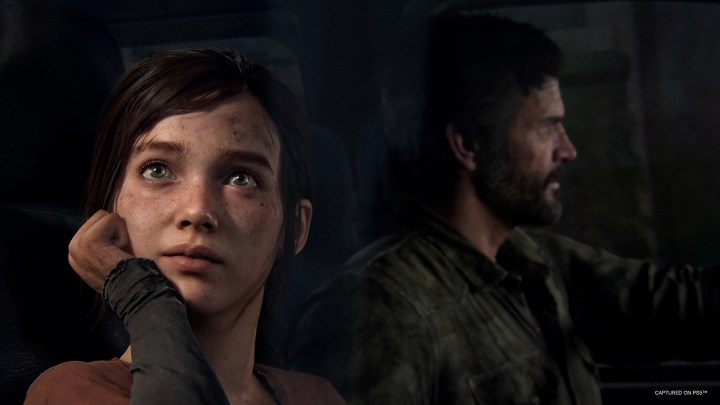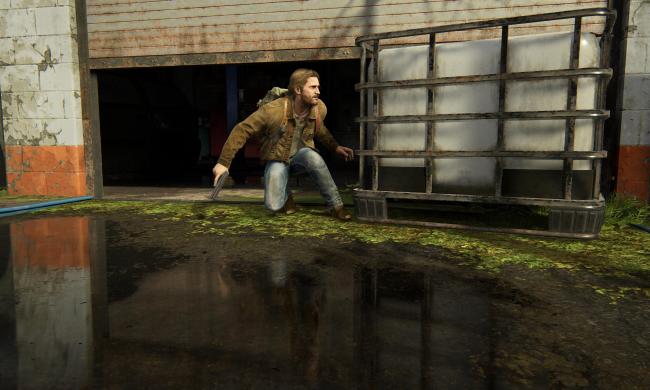“Though its visual upgrades feel superfluous, The Last of Us Part I makes key innovations in accessibility that'll allow more players to enjoy an enduring classic.”
- Story is still powerful
- Left Behind has aged wonderfully
- Some notable tech boosts
- Bonus modes add replay value
- Landmark accessibility
- Hardly a remake
- Pricey for what's offered
After taking a few years off from gaming, I bought a PS4 in 2014. It came bundled with a free copy of The Last of Us Remastered, a game I didn’t know much about outside of its sterling reputation among critics. Less than a week later, I found myself staring at my TV, my mouth hanging open as I processed the game’s stunning final hour. “So, this is what video games can do,” I thought to myself. My previously narrow view of the medium as escapist entertainment was smashed wide open like a golf club to a skull.
A lot has changed about video games between then and the release of The Last of Us Part I, Sony’s new PS5 remake of a PS3 classic that got a PS4 upgrade. While it was a revelation even still in 2014, developers have since taken its coveted blood and injected it into everything from God of War to Tomb Raider. Returning to the PS5 glow-up eight years after I first played the remaster feels a bit like going back to 1985’s Super Mario Bros. While many games I play today have its DNA, it’ll always be patient zero.
The Last of Us Part I shows that Naughty Dog’s gritty action game is still an enduring classic that hasn’t aged a day. Though that’s largely because Sony won’t allow it to, as evidenced by a mostly superfluous remake that doesn’t meaningfully improve on the game’s perfectly modern (and much cheaper) 2014 remaster. However, the project does once again push the industry forward in an important way: by raising the bar for accessibility in gaming’s past, present, and future.
Still the best
The Last of Us Part I is a difficult game to critique for a variety of reasons that’ll become clear shortly. No matter how many philosophical gripes I have with the entire idea of the remake’s existence, it’s still the best version of what I’d consider the finest video game of the 2010s. Purely focusing on the text, it remains a phenomenal experience that few games have fully replicated — including its own sequel.
The game tells the story of Joel, a father surviving alone during a zombie-like apocalypse after his daughter is killed. Long after that tragedy, Joel takes on a job to transport a piece of precious cargo across the country. That cargo is Ellie, a young girl who is seemingly immune to the disease that turns humans into fungus-infested “clickers.” Perverting the fatherly ideal of the “protector,” Joel begins to treat Ellie like an unwitting surrogate daughter on his journey to deliver her to a group called the Fireflies.
The focused nature of The Last of Us is still the game’s best trait.
The brilliance of The Last of Us has always been in the way it preys on the player’s perception of video game protagonists. We assume Joel is a hero, because games largely place us in the game of the righteous good guy. The Last of Us pushes players to reexamine that idea, using the concept of the unreliable narrator to flip our once-accepted truths about video game language on their head. It’s an idea that only works as well as it does because of its interactive nature that puts the player in control of Joel’s actions – something the series’ upcoming TV adaptation will have to work around.
The enduring power of its devastating story is contingent on the moment when players look down and see the blood on their own hands. It lures players in with sickly satisfying stealth kills and gun combat (complete with gory violence that’s all the more glorious with enhanced visuals and a crisp 60 frames per second) before leading them to a horrific finale that re-contextualizes the entire game. Some find it to be a cheap trick. Others continue to miss the point entirely by rallying behind Joel as a lovable hero. Regardless of where you fall, it’s still the rare big-budget video game that’s cognizant of how play itself can deliver the message.

It’s especially illuminating returning to the game after 2020’s The Last of Us Part II, a game this re-release is clearly capitalizing on. The sequel is bloated compared to its predecessor’s sleek story. It tries to ask messy questions about the cyclical nature of violence, but can’t help but include a New Game+ mode where you get to keep all your cool guns in another playthrough. The focused nature of The Last of Us is still the game’s best trait, with impactful story beats interwoven with shining moments of tense stealth, zombie horror, and cinematic action.
In fact, the biggest revelation in the new package is just how fantastic the game’s Left Behind DLC still is, which also gets a makeover here. The two-hour story about Ellie scavenging for medicine in an abandoned mall stands up as one of Naughty Dog’s finest games in its own right. The bonus episode balances the tender and the tragic moments of human life, all while hitting the best mechanical beats of the main game in a more concise package that’s memorable from end to end.
If you’ve never played any version of The Last of Us, Part I preserves its power while adding a fresh sheen. If you have played it before, that’s an entirely different conversation.
Pretty for a price
It’s hard not to feel cynical about the project when moving beyond the confines of the text itself. Positioned as a ground-up remake and priced at $70 like a new PS5 release, The Last of Us Part I struggles to justify its own existence in many respects. It feels disingenuous to call it a remake considering how few of its improvements make a meaningful difference over its 2014 remaster. It’s like watching a 4K restoration of a film: It won’t change anything about your relationship to the work, just clean off your window to it.
The Last of Us was never good because of particle effects.
The Last of Us Part I is undoubtedly a better-looking game than the 2014 version. Fire ferociously billows through the streets in its harrowing opening sequence. Landscapes emphasize the beauty still present in the game’s hellish world with awe-inspiring graphical fidelity. Faces are more expressive, bringing extra power to moments like Ellie’s gut-wrenching final confrontation with Joel. And everything happens in a much cleaner 60 frames per second, making the action feel faster and more fluid than ever.
So why did nothing about my experience change?
After playing the remake’s iconic intro, I immediately fired up the remaster, streaming it off of PS Plus via the cloud. For my first few minutes, the difference felt significant. Everything was a little more unnatural during the game’s opening cutscene, from the more digital faces to the choppy framerate. And then I gained control. Within no time, my mind adapted to the visuals and I stopped feeling the frame dip entirely. My brain filled in the gaps and my reaction to the scene that unfolded was identical, more billowy flames be damned.

I spoke with my co-worker Tomas Franzese about my experience, questioning why I wasn’t wowed by features like the game’s radically improved particle effects. He replied, “The Last of Us was never good because of particle effects.”
He’s right. The Last of Us Remastered doesn’t look photorealistic, but who cares? When I think back to my experience with it, its technical output isn’t what sticks with me. It’s the atmosphere, the thoroughly imagined dystopian world, the emotional relationship with how I’m enabling Joel’s misguided quest. I might have had opinions on its sometimes clueless A.I. at the time (which is drastically improved in Part I), but any critiques have long since melted away. And when I talk about The Last of Us Part I in another 10 years, I sure as hell won’t praise or even remember the number of particles on screen.
The remake largely feels like a marketing opportunity for Sony, capitalizing on the game’s upcoming TV adaptation with a pricey upgrade. It does that without making any meaningful changes that alter my relationship to the work, something excellent remakes like Shadow of the Colossus or Demon’s Souls do. New features like companions having better exposure awareness will make for a great Game Developers Conference talk, but they won’t make someone who’s played the original feel like they’ve wisely spent their money.

I don’t mean to undermine the passionate work that’s gone into rebuilding The Last of Us Part I. Naughty Dog has transformed a two-generations old game into a modern marvel. It has even included nifty new features, like permadeath and speedrun modes, that’ll give old fans a new reason to play. But the best remakes preserve the feeling of playing a game when it first released, making it look as impressive as it did at the time. The Last of Us Part I does feel the same as I remember it in 2014. But that’s because it is.
Accessibility in hindsight
There is one thing that’s changed for me between playing the remaster and remake: I’ve since become extremely nearsighted. When I played the game in 2014, I sat ten feet away from a 42-inch 1080p Vizio screen crookedly mounted on my wall and could see every detail. I played The Last of Us Part I on a 55-inch 4K TCL display from five feet away and needed to lean forward if I wanted to get a clear look at it.
The remake is going to allow people who were physically unable to play the game a chance to experience it for the first time.
That’s where the remake’s actual improvement comes into play. The Last of Us Part I includes a large suite of accessibility options that allow fans to tailor the experience to their needs. Some of those options are simple, like increasing caption sizes. Others are groundbreaking, like the ability to enable spoken audio descriptions for cutscenes. The remake is going to allow people who were physically unable to play the game a chance to experience it for the first time. Frankly, that’s more important than any facial hair texture.
I can’t begin to guess how effectively the game will cater to every player, but I can tell you about my own experience. Before starting the game, I went into the menus and began picking options like I was ordering sushi from a menu. I knew my hurdles would be visual, so I bumped up the size of the HUD elements to start — a seemingly fundamental option that some games still lack. But what really got me excited was the long list of audio cues I could enable. For instance, lootable items are usually marked with a small white triangle button prompt. Rather than straining to see it, I could toggle on an audio cue that would ding like a Wheel of Fortune board when I was close to something I could grab.

I could make some other cues tactile thanks to the DualSense controller. Usually aiming would be tricky in a game like this, as I can sometimes have trouble clearly focusing on a faraway target. Here, I was able to enable a gentle vibration any time my crosshairs were lined up with an enemy, letting me know I was where I wanted to be. The innovations go even deeper. One incredible option translates all dialogue to haptic vibrations, allowing players to feel how lines are being delivered. My eyesight condition is minor (and I can easily toss on a pair of glasses to resolve it, unlike some visually impaired players), but with just over half a dozen options, I could easily play The Last of Us Part I just as well as I played The Last of Us Remastered.
Accessibility isn’t only about settings in a menu. It has to be baked into the game’s game design from the beginning, and naturally that’s not going to happen with a 1:1 remake of a 10-year-old game. There are some misfires here, like treating game speed reduction (a key accessibility tool) as a bonus unlockable. And frankly, it’s a little gross to think that players who need the game’s upgrades will have to pay $70 to get them while others can experience the comparable remaster for $20. But what Naughty Dog has done here is admirable, taking a canonical classic that’s quintessential to gaming history and trying to make it a more inclusive experience. If it’s going to be a game that’s discussed for decades to come, more people need to be able to get into the conversation.
My critiques of The Last of Us Part I are largely philosophical, but those feel small when stacked up against the truly important work that’s been done here. If you’ve already played The Last of Us and feel outraged over what the remake offers, consider that it doesn’t have to be for you.
The Last of Us Part I was tested on a PS5 hooked up to a TCL 6-Series R635 TV.





